Make apple cider vinegar at home, using apple scraps or whole apples, with this easy tutorial. Save money, reduce food waste, and make ACV in under 5 minutes!
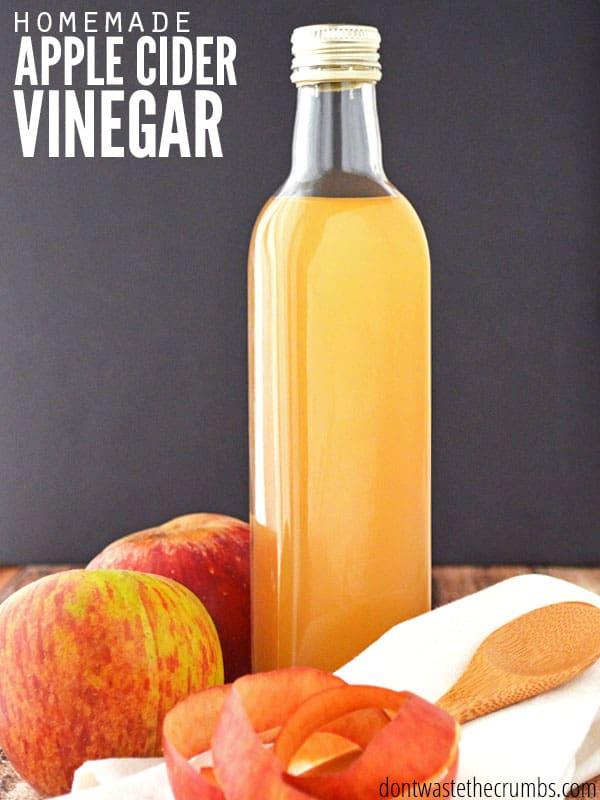
My kids absolutely LOVE apples. They’ll eat them fresh, dipped in Chocolate Hummus, or in their favorite make-ahead breakfast Apple Oatmeal Breakfast Bars (which also passes for dessert!).
But what do you do when you have a bunch of apples that go bad? Or have you ever wondered if there’s something you can do with the apple cores and apple peels, other than throw them away?
You can make apple cider vinegar!
Apple Cider Vinegar
There are two important things to know when you make ACV:
First, it’s free. There’s nothing special to buy just to make apple cider vinegar. You can use apple scraps (cores and peels) from any other recipe, OR you can use apples that don’t look very appetizing. In either case, you were going to throw the apple bits and pieces away anyway, so turning it into vinegar is a free bonus! (Here are more ideas for cooking with food scraps).
Second, making apple cider vinegar is VERY easy and VERY fast. You only need 3 ingredients and the entire process takes only 5 minutes from start to finish. The only downside is that your apple scrap vinegar is not officially ready until it’s sat for about 6 weeks.
If you need apple cider vinegar ASAP, the healthiest option is to purchase a brand that is raw, unpasteurized and has the mother. I really like Braggs, and you can get the best deal by buying in bulk.
You can still benefit from pasteurized apple cider vinegar though, so if that’s what’s in your budget, go for it!
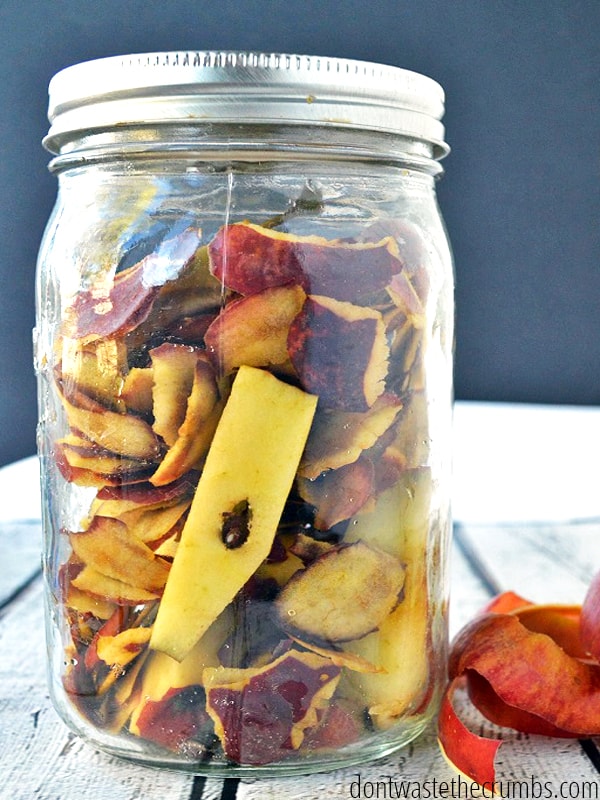
ACV Benefits
ACV benefits include reducing high cholesterol, stabilizing blood sugar, and improving heart health. It also aids in detoxing the liver and lymphatic systems.
Raw, unpasteurized apple cider vinegar will also have “good” bacteria (like yogurt) and enzymes that improve gut health. I want all of these health benefits, but store-bought can be pricey, which is why I learned how to make my own apple cider vinegar!
Supplies for Making Vinegar
- One wide mouth quart mason jar (or reuse a glass jar from spaghetti sauce or peanut butter)
- One canning lid ring (if using a canning jar) OR a rubber band
- Coffee filter OR paper towel
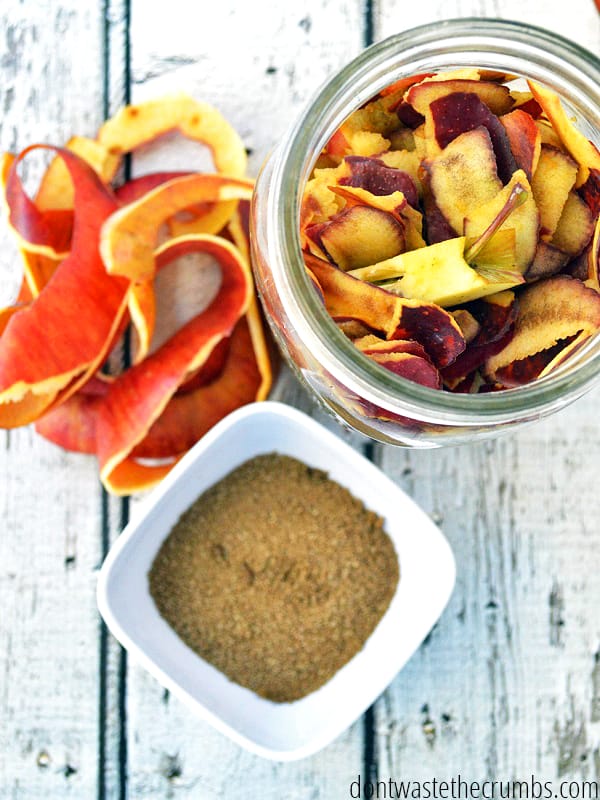
Homemade Vinegar Ingredients:
- Apple scraps from approximately 6 large apples (NOT moldy or rotten apples)
- 2 Tbsp granulated sugar (white granulated sugar is best)
- 2 cups water, boiled and allowed to cool
Tip: If you don’t have enough apple scraps to make ACV, freeze the cores and peels until you do! Place them in an airtight container that’s safe for the freezer. Label the container, and simply add additional cores and/or peels to the container as you have them. When you have about 6 apples worth, make homemade vinegar!
How to Make Apple Cider Vinegar at Home
Step 1: Measure 2 Tbsp of granulated sugar and ¼ cup of water into the quart jar. Stir until the sugar is dissolved.
Step 2: Fill the jar with apple pieces, filling no more than ¾ full. The apple scraps need room to expand and stay under the liquid.
Step 3: Add the remaining 1 ¾ cups of water to the jar. The apples should be completely submerged. Mold can grow on any portions of apples that are not covered and ruin your batch of vinegar. If your scraps float to the top of the jar add fermentation weights, fermentation springs, or a smaller jar on top (or a shot glass) to keep them submerged.
Step 4: Cover the top of the jar with a coffee filter and secure it with a canning lid or a rubber band.
Step 5: Allow apples to sit in a warm, dark place for two weeks. Above the refrigerator or on the top shelf of a cupboard are great places. Just don’t forget you put it there!
Step 6: After 2 weeks, you might notice some fizz or bubbles. That’s good news! Strain out the apple pieces and discard them. Cover the apple cider vinegar again with a filter and canning lid ring (or rubber band). Allow the vinegar to continue to sit at room temperature for another 2-4 weeks.
Step 7: The vinegar may become cloudy, or a SCOBY could form on the top, both of which are normal. At the 4-week mark from first initially making the vinegar, taste test the vinegar once a week until it’s fermented to your liking. You can stop the fermentation process by replacing the filter with a canning lid and storing it in the refrigerator.
For longer storage, I highly recommend swing-top glass jars like these. They keep the apple vinegar sealed to prevent further fermentation, and they’re easy to pour from. Plus, it frees up your mason jar for other things.
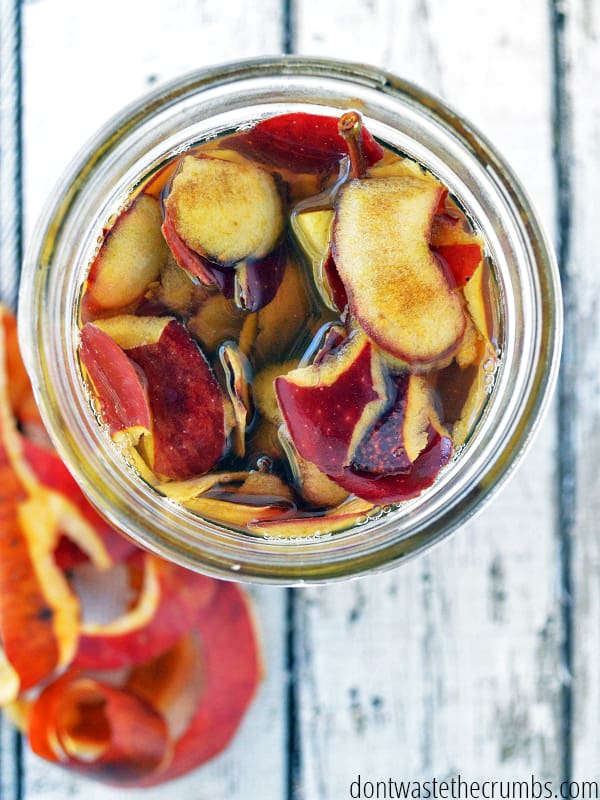
How to Make ACV (Using Whole Apples)
Follow the steps above for making apple cider vinegar using apple cores and apple skins, except use apples that are past their prime or not best for eating fresh, like mealy apples, wrinkly apples, or apples with bad spots. Simply cut out any bruises or bad spots from the apple and follow the tutorial as written to make ACV!
Does Apple Cider Vinegar Go Bad? ACV Storage Tips
Refrigerator: Store finished apple cider vinegar in the fridge to stop the fermentation process. You can keep it out on the shelf, but it will continue to get stronger in taste.
Freezer: I have not tried freezing ACV before, but I think you can! Use these tips to freeze liquids without breaking the jars.
Shelf-Life: Homemade apple cider vinegar will last up to a year when refrigerated. You should be able to tell by smell and taste if it has gone bad. The smell should always be vinegary with a hint of sweetness. If it smells sour, toss it, and start a new batch.
How to Make ACV: Troubleshooting and Tips
Make sure ALL of your supplies are clean. Dirty dishes can contaminate your homemade apple scrap vinegar, so be sure to start with a clean kitchen and a sterilized jar, clean bowls, and utensils.
Avoid chlorinated water. Most cities use chlorine to combat bacteria in water, but this small amount of chlorine can react with fermentation and vinegar. Be sure to use filtered water or boiled water that has cooled.
Don’t use metal containers. Metal containers will also react with fermentation and vinegar, so make sure you’re using only glass jars. (Silicone, wood, and plastic utensils are fine to use.)
Speed up the process: You can use apple cider vinegar as a “starter” and add 1 ½ Tbsp raw apple cider vinegar for every 2 cups of water to help kick start and speed up the fermentation process. If you do this, strain the apples after just one week and taste each week after that.
Make sure your jar is covered well with a coffee filter or paper towel so fruit flies can’t get inside!
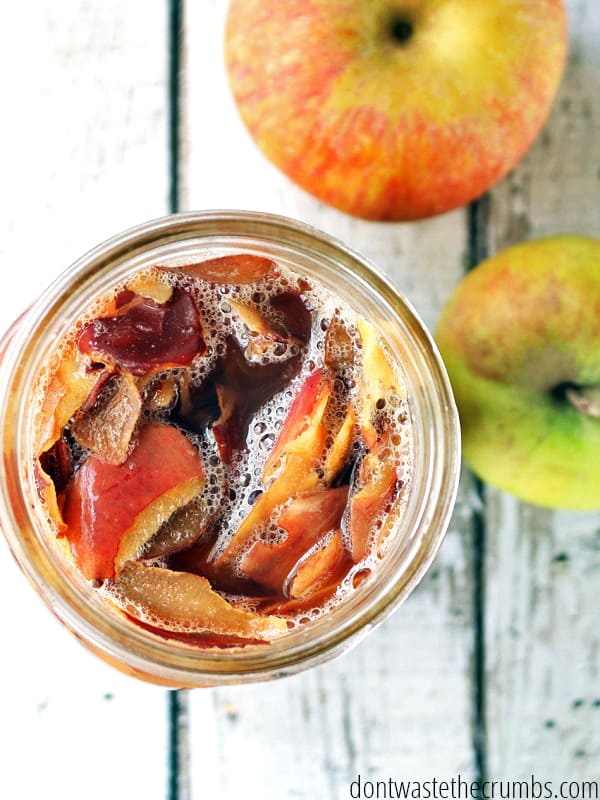
FAQs to Make ACV
What apples are best for making homemade apple cider vinegar?
The best apple types for homemade apple cider vinegar are the ones you already have at home! Seriously, there’s no right or wrong apple variety to make ACV. I think a combination of apples tastes best, but you could use a different fruit altogether – pear cider vinegar, pineapple vinegar, permission, fig, or anything else that sounds good to you!
Can I use honey instead of granulated sugar for fermentation?
You can substitute raw honey for sugar, but it will cause slower fermentation. Any sweetener you use will be eaten by the yeast anyway, so I prefer to use the least expensive sweetener possible. You can also omit the sweetener altogether, but the total fermentation time will be up to six months.
Can I make ACV from the mother?
Yes! You can use the vinegar mother from an existing ACV or a SCOBY as the starter in your next batch of ACV. Or you can give it to a friend to start her own batch of ACV!
How do you make apple cider vinegar at home?
Follow the tutorial above for making apple cider vinegar from entire apples or using apple cores and apple peels. Keep reading for ways to use your homemade apple cider vinegar in recipes and around the house!
My vinegar is moldy. Is it still good?
You will usually find white scum at the top when you make ACV, but you shouldn’t find mold. Be sure your apples stay submerged using fermentation weights, fermentation springs, or a smaller jar on top (or a shot glass). If you find mold in your apple vinegar, toss it out and try again.
What color should homemade apple cider vinegar be?
There are a lot of factors that affect color when you make ACV. It could be the apples you use, how long it ferments, and the temperature of where you store it! Mine typically stays a light color but has a distinct vinegar smell and taste.
What if my ACV turns slimy or thick?
Apples naturally contain a lot of pectin. This is what is used to thicken jellies and jams. If your ACV becomes thick, you can continue to ferment and then thin with water later. Organic homegrown apples tend to contain more pectin!
How Do You Use Homemade Apple Cider Vinegar?
Personal Use:
- As a detox elixir. Use this recipe for a short-term detox or an everyday start for your digestive system.
- An immune system booster. In addition to these immune-boosting fall foods, a tablespoon of ACV contains polyphenols and polysaccharides, which help your immune system.
- A facial toner. After using a homemade face wash like this, you can use apple cider vinegar as a toner. Top off with homemade lotion bars and your skin will thank you!
- To remove moles. I know this seems strange, but my husband tried it and it worked! Here’s his story.
- Homemade conditioner. Naturally condition hair with homemade ACV!
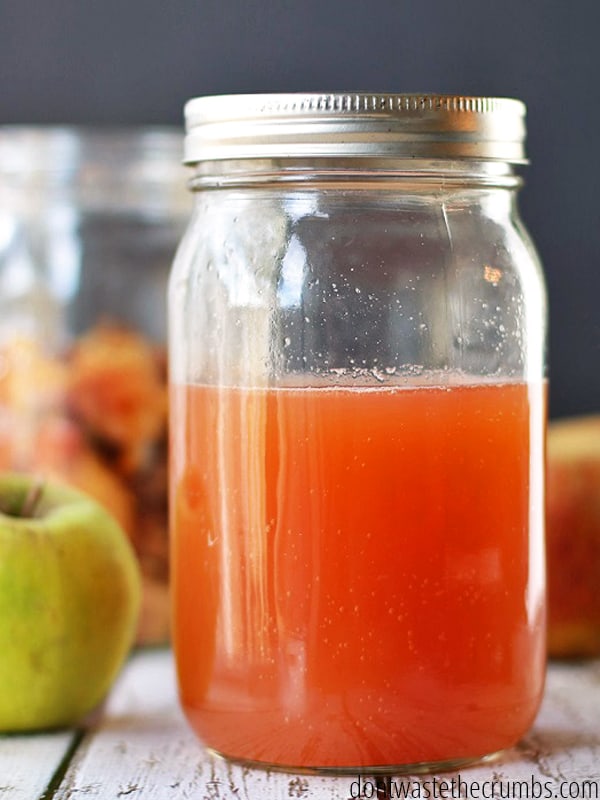
In the kitchen:
- To soak grains. Here is my method for soaking whole grains. Adding some apple cider vinegar helps the process work faster.
- To make salad dressing. This delicata squash salad recipe is one of my favorites that uses an apple cider vinegar dressing.
- Substituting for plain vinegar in recipes. Apple cider vinegar works really well in most recipes!
- Make bone broth. Whether you use the slow cooker chicken stock method or the Instant Pot chicken stock recipe, add 1-2 Tablespoons of ACV. This helps pull the nutrients out of the bones creating a true bone broth.
- In homemade mayo. My recipe for fail-proof mayo uses lemon juice. But if you’re out or don’t have fresh lemons on hand, ACV works in a pinch! The flavor is slightly different but still makes great mayo.
- Washing produce. Using vinegar is one of the natural ways to wash vegetables!
Around the house:
- To catch stray fruit flies. I tried this not long ago and it really works! The flies didn’t stand a chance in our homemade trap.
- To clean the house. You can take your finished apple cider vinegar and infuse it with citrus peels. This creates a nice-smelling cleaner you can use anywhere in the house.
Apple Recipes to Make Before You Make ACV
- Homemade Applesauce
- Apple Butter (plus 7 variations)
- Slab Apple Pie
- Homemade Apple Crumble Ice Cream
- Dehydrated Apple Chips
- Cranberry Apple Spinach Salad

No Cook Meal Plan
Sign up to get instant access to my No Cook Meal Plan, complete with recipes and shopping list!How to Make Apple Cider Vinegar
Make apple cider vinegar at home, using apple scraps or whole apples, with this easy tutorial. Save money, reduce food waste, and make ACV in under 5 minutes!
- Prep Time: 6 weeks
- Total Time: 6 weeks
- Yield: 32 oz 1x
- Category: Kitchen Hacks/Tutorials
- Method: Fermentation
- Cuisine: American
Ingredients
- Apple peels, cores and any browning/discolored flesh from pesticide-free apples (approx 6 large apples)
- One quart jar like these (or whatever you have on hand)
- One canning lid ring OR a rubber band
- Coffee filter OR paper towel
- 2–2 ½ Tbsp granulated sugar (I like Turbinado raw sugar)
- 2–2 ½ cups water, boiled and allowed to cool
Instructions
- Cover the bottom of your jar with apple scraps, filling no more than ¾ full. The apples need room to expand and stay submerged.
- Add 2 Tbsp of granulated sugar and 2 cups of filtered water to the jar. The apples should be completely submerged. Mold can grow on any portions of apples that are not covered and ruin your batch of vinegar. If your scraps float to the top of the jar add a smaller jar on top to keep them submerged.
- Stir the apples, sugar, and water and cover with a coffee filter. Secure with a canning band, or a rubber band.
- Allow apples to sit in a warm, dark place for 2 weeks. Above the refrigerator or on the top shelf of a cupboard are great places. Just don’t forget you put it there!
- After 2 weeks, you might notice some fizz or bubbles. That’s good news! Strain out the apple pieces and compost. Cover the apple cider vinegar again with a coffee filter and canning band. Allow continuing to sit at room temperature for another 2-4 weeks.
- The vinegar may become cloudy or a SCOBY could form on the top, both of which are normal. Taste test the vinegar once a week until it’s to your liking. You can stop the fermentation process by replacing the coffee filter with a canning lid and storing it in the refrigerator.
Notes
- Avoid chlorinated water. Most cities use chlorine to combat bacteria in water, but this small amount of chlorine can react with fermentation and vinegar. Be sure to use filtered water or boiled water that has cooled.
- Don’t use metal containers. Metal containers will also react with fermentation and vinegar, so make sure you’re using only glass jars. (Silicone, wood, and plastic utensils are fine to use.)Speed up the process: You can use apple cider vinegar as a “starter” and add 1 ½ Tbsp raw apple cider vinegar for every 2 cups of water to help kick start and speed up the fermentation process. If you do this, strain the apples after just one week and taste each week after that.
- Make sure your jar is covered well with a coffee filter or paper towel so fruit flies can’t get inside!
Nutrition
- Calories: 23

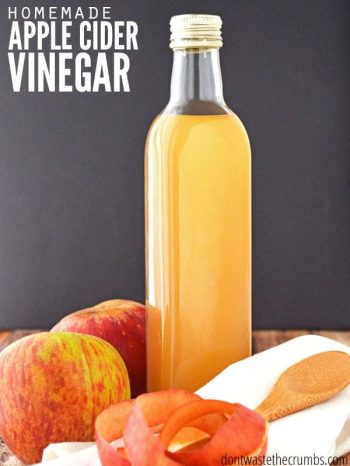
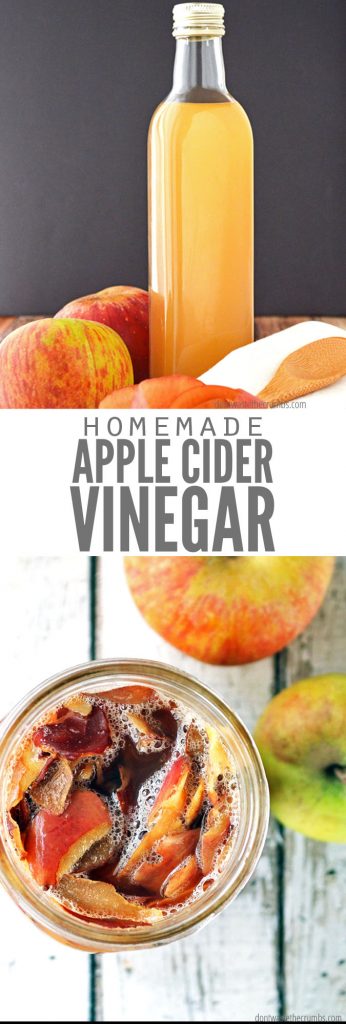

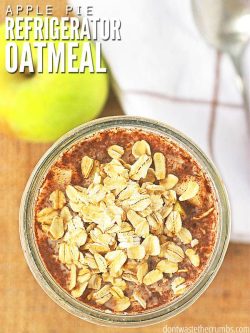
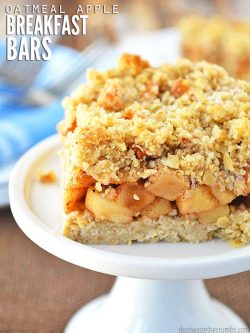


Wonderful advice from all the comments. Thanks. I wish I read them BEFORE I tried this.
I used a shot glass upside down… It was the only thing I could find small enough and I figured it was the most sterile. I noticed action after about a week. The filter was puffed up and completely soaked, dripping liquid down the sides of the jar and puddling at the bottom. There was lots of bubbling when I lifted and tilted the jar so I wiped it up, replaced the filter with a dry one and carried on. After another couple days, same thing, only this time I could actually smell the mould ( I’m super sensitive to smells). So, I threw it all out!
But, I will definitely try again. This time, maybe not fill it so much with apples. I have one weird question. When you say apple cores, do you mean to include the ones that have been left after eating, or cut away? I’d think it would be ONLY cut away, but thought I’d ask anyways.
Thanks for blogging. I’ve learned a lot. ?
Glad the comments are helping you AnnieVee! As for the apple core, I would NOT use eaten cores for ACV, just cut. But eaten cores can go into smoothies for sure!!
Mine developed a SCOBY on top. What should/can I do with it?
Composting would be best Valerie. I’ve never worked with an ACV scoby before (just kombucha), so I’m not entirely sure what to do with it. BUT – if you wanted to try another batch using the scoby to start, that would be an interesting experiment (with nothing lost since you’re using trash anyway, right?) 🙂
I just want to say thanks again for this recipe. My first try didn’t work out because of mould. But my second worked wonderfully. I used it on salads and cooking but the most amazing thing was that I used it to cure my son’s planters wart in two weeks. Before this home made concoction, this beast was bad, let me tell you. I took him to the doc twice to try and have it removed with liquid nitrogen with no success. In fact after the first treatment the emperor struck back and spread to his other foot in spite of all my efforts to keep the wart covered.
Here’s what I did…
Cut the tip off a cotton swab and soak it in the homemade vinegar.
Apply the soaked cotton tip directly to the wart.
Cover the soaked cotton tip with duct tape trying to centre it on the wart.
Leave it covered for two days.
Repeat process.
After asking my pharmacist nephew was really surprised by the results of this home remedy. He figures the acv may have changed the ph of the surface of the skin making it unfriendly to the beast.
This is amazing MW – congratulations! And to think – it all stemmed from what was originally going to be trash!! 🙂
made two seperate jars at same time one is slimy the other not? ive read that slimy is ok and to keep going…what do you mean keep going? keep peels in or strain them it has been two weeks with peels.
If it’s been two weeks with peels, go ahead and strain, but keep letting it ferment until it’s the desired acidity.
If you aren’t opposed to using plastic, I’ve used a plastic zip top bag partly filled with water and zipped up to place on top of your jar of fruit or pickles or whatever you’re trying to ferment. Remove all the air out of the bag of water so it will conform to the inside of the jar. Push the bag of water directly down into the liquid to hold the fruit under the surface. This will keep the fruit submerged and since it doesn’t actually seal the jar, the gas from the fermenting process will escape around the edge of the bag of water. You may want to place your jar of apple scraps and water into a bowl to catch liquid that might run over the lip of the jar if you have it too full. This might work best with a larger jar such as the gallon size sun tea jar. Also a pint size canning jar filled with water and the lid screwed on should fit in most gallon size jars to hold the fruit down. Using the pint jar would work best if the gallon size jar is full enough of apple scraps so the pint jar sets above the rim of the gallon size jar so that you can get hold of the pint jar to pull it out. Just cover the whole thing with a cotton towel or cheesecloth and put a rubber band or string or whatever around the cloth to hold it onto the gallon jar.
Thanks for the ideas Dan!!
Just a thought. I would think glass shot glasses, turned upside down, would work to keep the fruit submerged. ?
Ooh, nice thinking Kelly!
Can I make this with apple cider, the natural kind, Not processed like juice?
I haven’t tried that James, but you’re welcome to experiment!
Hi Tiffany, I am trying to do the ACV as you described above. My mixture stands now for 3 days..is it normal that the liquid becomes like jelly? Thank you!
Hi Peggy! The whole thing like jelly? I wouldn’t think so… but apple peel contains pectin, and that is used to make jelly. Natural cultures can also possibly form a scoby, although the chances are slim. I’m not sure what is going on, but if it smells ok, I’d keep going. Maybe you’ll just have to dilute once it’s done to thin?
Pretty much the whole thing yes…there is no liquid anymore..it’s all jelly, but otherwise it looks and smells good. The apples are out of my neighbors garden and 100% organic, maybe it’s one the kinds which has a lot of pectin. I will continue and see. Thank you Tiffany☺
Ah, mine is also very very viscous, kind of like a sticky clear gel or slime. Still looks fine, smells great. A friend of mine thinks maybe pectin? I can’t really find any information about what to do — if you should just leave it, or if you need to add a brewer’s enzyme to break it down? Mine is not a total gel, just thicker, almost like a light syrup.
I just strained mine and I have the same situation, more like a thick syrup. I don’t have an answer for you, just adding on here to see if someone else has had this result as well.
Hi there,
I’ve been working on my acv for probably 3 weeks. Right now it’s just a cloudy color and smells a little fermented. There isn’t any bubbling going on.
Should I add more apples and keep it going? Or do I need to start over?
How do you know when it’s time to take the apples out?
Thanks
Hi Kelsey! It sounds like it’s right on track! You can take the apples out now and if you want it to keep fermenting for a higher level of acidity, let it keep at room temperature. Otherwise cap it and call it done!
HI Tiffany. Did you ever get around to testing the Ph level out of interest?
Hi Sophia – I didn’t. We ended up packing up and moving across the country and I haven’t started a new batch of vinegar yet!
On other recipes it says to leave the apples in the mixture until it has been turned to vinegar, is there a reason you strain them out beforehand?
To help prevent the formation of mold on the fruit LC. 🙂
HELP!!! I made this 2 times but wasn’t successful. I have it on my counter all covered up so it’s warm enough since it’s the change of the season, but it never gets real vinegary(is that a word)? It’s always weak.
What am I doing wrong?
If it smells sweet, I’d just let it go longer. How long has it been Sue?
Hi there! love the instructions.. I’m making fig,strawberry,white grapes and red grapes vinegar atm and they are all turning out really well.. i can see the scum on top and no mold BUT i covered the entire thing with unfiltered coconut vinegar and did not add water at all.. it’s going to be too strong.. can i add purified water at this stage? it’s only been a week now.. can i add water now? or should i add it later after filtering the fruit after few weeks?
Hi there! love the instructions.. I’m making fig,strawberry,white grapes and red grapes vinegar atm and they are all turning out really well.. i can see the scum on top and no mold BUT i covered the entire thing with unfiltered coconut vinegar and did not add water at all.. it’s going to be too strong.. can i add purified water at this stage? it’s only been a week now.. can i add water now?
Thanks for the recipe. I was wondering if I could seal the jars? I just don’t want my house to stink up while I am making the vinegar… Or are there any tips to prevent the smell to cover the house while you are making this?
What should I do with my container of apple cores while I’m waiting to accumulate enough to start a batch, it could be a few weeks before we eat enough apples? Fridge?
Fridge or freezer Ashley, depending on how long you’re storing. 🙂
I am going to try your recipe for making a video. My question is, when you get the “mother” how do you use her to make more accurate? I am excited about making this. My daughter is making some now.
Sorry, the above comment was suppose to say ” make acv” not a video. Crazy spell check. Lol.
LOL – no worries!
I’m not sure if I follow Vickie… the “mother” in ACV is a stringy set of bacteria that doesn’t necessarily clump together like a scoby does. What do you mean by “making more accurate?”
Wow! Guess I really need to read my comments before I post. Evidently spell check doesm’t like “acv”. Lol
What I was trying to say is, what is the process of using the “mother” to make more acv?
Sorry for the confusion.
Hi, Love these instructions – lots of pretty pictures. I am at week 2 and one of my jars has got a fat, juicy scooby on it, but the entire thing is like a dark garnet to black color. It smells ok, actually good. The other jar is sort of tan in color. I just wondered if you could explain the color differences? TIA
I think it’s fair to say there is no “right” color. So many variables when you’re doing this in your own space. Light exposure, oxygenation (how well vented the top is) temperature to name a few. As long as it smells good, you’re probably fine. The batch in my basement is almost 10 months old. Smells and looks great, but I don’t think I’d be too worried about the color as long as the smell is right and there’s no mold. That said, go with your gut. If it doesn’t seem right, it’s not a huge investment you’re tossing.
Great answer Andrew – thank you for chiming in!
Hi I have 2 batches going. One is still very light and one is light and thick like a syrup. Is this right? I have never bought acv
If you don’t have mold, you’re good to go Jaime. The batches will be different for various reasons. It shouldn’t have a funny smell either, by the way. 🙂
I recently tried this and they got moldy 🙁 I was so sad I had to dump three beautiful jars of acv. I had plenty of water to cover the apples but they kept floating. Any tips on keeping them submerged?
Hi, Jenn. I couldn’t find anything to keep mine submerged either, so I just checked on it everyday. I took a spoon and pressed everything down once a day for the first 2-3 weeks. It’s more of a pain, but for me it was better than having it go to waste. Hope that helps.
Does using a coffee filter vs cheesecloth keep the fruit flies out? My mom is making a few jars, but covering with cheesecloth, and they all have fruit flies.
I’m not sure if the covering makes the difference, but rather where you live and climate. I’d try keeping behind a pantry door to keep the flies out.
The couple batches I’ve made I have used a coffee filter. No flies, and it let’s the stuff “breath” while it does it’s thing.
Thank you Andrew!